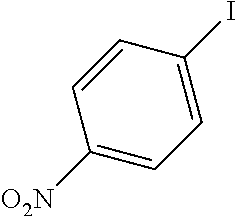Metal-containing organosilica catalyst; process of preparation and use thereof
a technology of metal-containing organosilica and catalyst, which is applied in the direction of metal/metal-oxide/metal-hydroxide catalyst, organic compound/hydride/coordination complex catalyst, physical/chemical process catalyst, etc., can solve the problem of removing residual metals from the reaction product and presenting a challeng
- Summary
- Abstract
- Description
- Claims
- Application Information
AI Technical Summary
Benefits of technology
Problems solved by technology
Method used
Image
Examples
example 1
Preparation of Palladium-Containing Organosilica Catalyst
[0054]A mixture of MTES (27 g, 30 mL, 151.4 mmol) and 10 mL of 0.042 M HCl(aq) (0.42 mmol H+ and 555 mmol H2O) is stirred vigorously for 15 minutes (or until the solution is homogeneous). The resulting solution is concentrated on rotavapor at 30° C. under reduced pressure until complete ethanol removal (with completeness being ensured by weighing). The resulting hydrogel is doped by addition of a solution of K2PdCl4 (from 0.004 to 0.018 equiv) dissolved in distilled and deionized water for better solubility and 60 mL acetonitrile. To this mixture is added NaOH(aq) 1M (from 0.023 to 0.053 equiv) to favor the gelation process. The resulting homogeneous and clear gel is left open to dry at ambient temperature for about 4 days. The xerogel thereby obtained is then reduced at room temperature with a solution of sodium triacetoxyborohydride in THF (Pd:Na(AcO)3BH=1:6 molar ratio; 80 mL), washed with THF and H2O and left open to dry a...
example 2
Palladium-Containing Organosilica Catalytic Reactions—Suzuki Coupling
[0058]A mixture of the desired haloarene, the phenylboronic acid and the potassium carbonate K2CO3 in methanol, 1-butanol or ethanol is refluxed for 15 minutes or more until it became homogeneous. The catalysts described in example 1 are added with respect to the substrate. After completion of the reaction (monitored by TLC and GC / MS) the catalyst is filtered, the solvent is evaporated and the residue is treated with ethyl acetate. The solution is filtered and the evaporation of the solvent gave the coupling product, purified by flash chromatography (eluent used is 5:1 hexanes-acetone). The results are summarized in Table 2.
TABLE 2Suzuki coupling reactionmol %PhB(OH)2K2CO3bConv. / EntryPh—XaCatalyst(equiv)(equiv)SolventTimeYield (%)2-1 0.1 mol % Si—Pd-11.793.72MeOH (0.07 M)15min1002-2 0.1 mol % Si—Pd-21.793.72MeOH (0.07 M)15min1002-3 0.1 mol % Si—Pd-31.793.72MeOH (0.07 M)15min1002-4 0.1 mol % Si—Pd-41.793.72MeOH ...
example 3
Palladium-Containing Organosilica Catalytic Reactions—Sonogashira Coupling
[0059]A mixture of the 4-iodo-nitrobenzene (237 mg, 0.952 mmol, 1 equiv), the phenylacetylene (102 mg, 0.997 mmol, 1.05 equiv) and the potassium carbonate (420 mg, 3.04 mmol, 3.2 equiv) in 40 mL EtOH / H2O is refluxed for 15 minutes or more until it became homogeneous. The catalysts described in example 1 are added with respect to the substrate. After completion of the reaction (monitored by TLC and GC / MS) the catalyst is filtered, the solvent is evaporated and the residue is treated with ethyl acetate. The solution is filtered and the evaporation of the solvent gave the coupling product. The results are summarized in Table 3.
TABLE 3Sonogashira coupling reactionmol %Ph—C≡CK2CO3TimebConv.EntryPh—XaCatalyst(equiv)(equiv)Solvent(h)(%)3-10.1 mol % Si—Pd-11.053.2EtOH / H2O0.251003-20.1 mol % Si—Pd-21.053.2EtOH / H2O241003-30.1 mol % Si—Pd-31.053.2EtOH / H2O241003-40.1 mol % Si—Pd-41.053.2EtOH / H2O24100a: Catalysts identifie...
PUM
| Property | Measurement | Unit |
|---|---|---|
| molar ratio | aaaaa | aaaaa |
| frequency | aaaaa | aaaaa |
| frequency | aaaaa | aaaaa |
Abstract
Description
Claims
Application Information
 Login to View More
Login to View More - R&D
- Intellectual Property
- Life Sciences
- Materials
- Tech Scout
- Unparalleled Data Quality
- Higher Quality Content
- 60% Fewer Hallucinations
Browse by: Latest US Patents, China's latest patents, Technical Efficacy Thesaurus, Application Domain, Technology Topic, Popular Technical Reports.
© 2025 PatSnap. All rights reserved.Legal|Privacy policy|Modern Slavery Act Transparency Statement|Sitemap|About US| Contact US: help@patsnap.com



